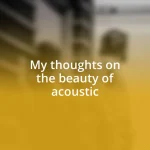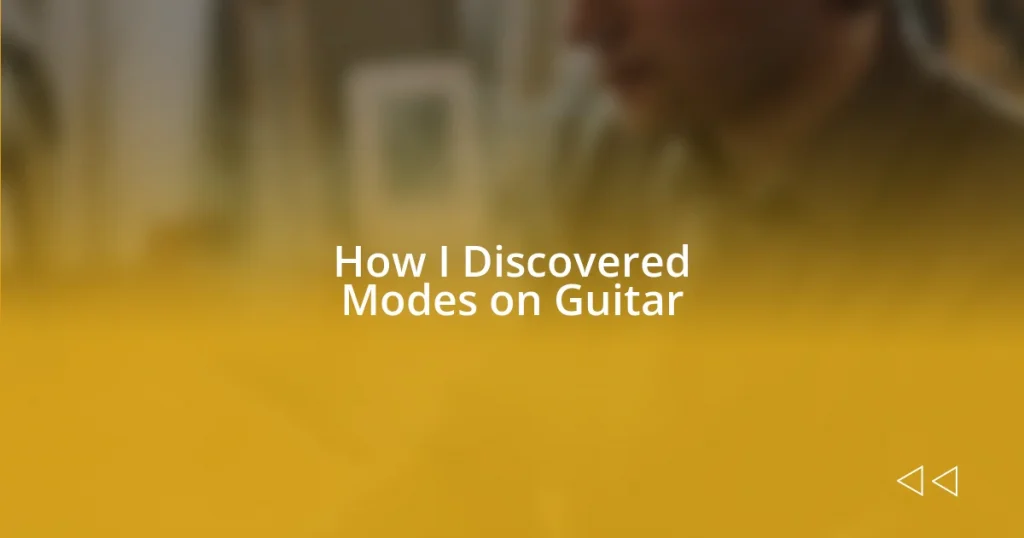Key takeaways:
- Understanding and experimenting with guitar modes can profoundly influence the emotional expression and character of music, akin to painting with colors.
- Initially, mastering modes can be challenging, involving confusion with terminology and emotional disconnection, but patience and practice lead to a deeper understanding.
- Modes can enhance songwriting and improvisation by providing diverse emotional textures and allowing for creative exploration, especially when blending different modes together.

Understanding Guitar Modes
When I first stumbled upon guitar modes, it felt like I had uncovered a hidden treasure map. Modes are essentially different scales that can transform the mood of a piece, each carrying its own unique flavor and nuance. Have you ever noticed how a single melody can feel completely different when played in various modes? It’s a fascinating experience that truly expanded my musical horizons.
As I delved deeper, I realized that understanding modes goes beyond just memorizing patterns. Each mode—whether it’s Dorian with its jazzy character or Phrygian with its exotic feel—has its own emotional signature. I remember playing a Dorian scale over a simple chord progression; suddenly, it felt like I was telling a story filled with longing and aspiration. It was a revelation to me: modes are like colors on a palette, allowing us to paint our musical narratives.
Now, I often think about how modes can elevate our playing. When I practice scales, I don’t just go through the motions; I immerse myself in each mode’s atmosphere. Have you ever tried improvising in a specific mode? It can lead to unexpected discoveries in your sound, unlocking creativity you didn’t know was there. The more I explore, the more I realize that modes aren’t just theoretical concepts—they’re living, breathing pathways to express the deepest emotions through my guitar.

My Initial Struggles with Modes
There was a time when modes felt like a puzzle I couldn’t quite solve. As I dived into this new concept, I often found myself overwhelmed with all the different scales. I’d sit with my guitar, reaching for notes that were meant to sound vibrant and intriguing, yet they always seemed just out of my grasp.
- I struggled to remember which notes went with each mode.
- The terminology was confusing—words like “Ionian” and “Locrian” felt more like spell names from a fantasy novel than helpful musical concepts.
- My mind would race, trying to connect with the emotion behind the modes, but I frequently felt disconnected.
- I even tried journaling my experiences, but it seemed like I was just jotting down frustrations rather than insights.
One memorable evening, I distinctly recall playing a mixolydian scale, trying to evoke a joyous feel. But instead, my attempt spiraled into a muddled mess that lacked clarity. It was disheartening to hear something so promising become a struggle. Each time I faced the challenge, I would remind myself that it’s a process—a journey of emotional exploration that requires patience and practice.

Exploring Different Types of Modes
Modes are often compared to different moods; each one creates a vibe that’s entirely its own. I remember when I first experimented with the Mixolydian mode—it was supposed to bring a sense of festivity, yet I found myself grappling with an urge to break free from tradition. It was intriguing to see how a single scale can conjure different emotions depending on how it’s played. Each mode has its own story to tell.
In my explorations, I discovered that Dorian and Aeolian modes offer unique soundscapes yet share a commonality in depth. The Dorian mode felt rich and jazzy, while Aeolian struck a more somber, introspective chord. Just the other day, I was strumming through a Dorian progression, and the music swept me away, sparking a wave of creativity. Conversely, when I shifted to Aeolian, I found myself reflecting on memories—each note carried a sense of nostalgia. It’s amazing how modes can transport both the player and the listener.
As I navigated these modes, I found that the Phrygian mode introduced an exotic flair, often taking me outside my comfort zone. I recall one evening, jamming with friends, where someone suggested trying a Phrygian riff over a minor chord progression. The moment I adapted my playing, I could feel the energy in the room shift. Suddenly, our music felt alive, daring and adventurous. It’s experiences like this that truly illustrate the dynamic power of modes in shaping not just music, but the emotions we share as musicians.
| Mode | Characteristic |
|---|---|
| Dorian | Rich and jazzy, evokes longing |
| Aeolian | Somber and introspective, carries nostalgia |
| Mixolydian | Festive and upbeat, encourages freedom |
| Phrygian | Exotic and adventurous, pushes boundaries |

Practical Exercises for Learning Modes
One of the most effective exercises I found was to work with one mode at a time, creating a dedicated practice session for it. I’d loop the chords of a specific mode and just play around with it for a while. For example, when I focused on the Dorian mode, I would play a backing track and challenge myself to improvise melodies that capture the mode’s jazzy essence. This not only helped me internalize the sound but also allowed me to hear the character of the mode in real-time.
What truly surprised me was the moment I began to connect with the emotional depth of each mode. I remember creating a short piece in Aeolian and, as I played, I felt an almost overwhelming sense of introspection wash over me. I would often pause mid-practice, close my eyes, and let the music take me—what was this mode making me feel? Engaging emotionally with the music transformed rote practice into a meaningful exploration.
Another practical exercise that worked wonders for me was transcribing and learning solos that employed different modes. I once spent days analyzing a favorite solo that utilized the Phrygian mode. As I played it note for note, I began to appreciate how that exotic sound could be infused into my own improvisation. Have you ever noticed how some solos just stick in your mind? Diving into those can reveal hidden gems about how modes interact with each other, and believe me, it makes all the difference in your own playing.

Applying Modes to Songwriting
One sunny afternoon, I found myself stuck while writing a new song. I decided to play around with the Aeolian mode to tap into that somber, reflective vibe. As I fiddled with the chords, I remembered a few heart-wrenching moments from my past. Suddenly, the music flowed effortlessly, each note a brushstroke painting a picture of my emotions. Can you imagine how powerful it is to express feelings through music?
When writing melodies, I often lean into the Mixolydian mode for its uplifting quality. I recall a particular songwriting session where I strummed away, feeling the music spark joy in my heart. The bright, festive notes propelled me forward, and before I knew it, I had crafted a catchy chorus that felt like a celebration of life. It’s fascinating how a shift in tone can lead to a completely new direction in songwriting. Have you ever experienced a shift like that in your own music?
Another technique I often use is blending modes for added texture. I remember writing a piece that combined the Dorian and Phrygian modes. The jazzy richness of Dorian provided a warm foundation, while Phrygian’s exotic notes added intrigue and adventure. This layering not only made the song more dynamic but also allowed me to experiment with contrasting emotions. How often do you push yourself to mix sounds and feelings in your songwriting? It’s a fun exploration that always leads to exciting discoveries.

How Modes Enhance Improvisation
When I first started exploring modes, I quickly realized how they can breathe life into improvisation. For instance, I remember a jam session where I decided to focus on the Locrian mode. It was unlike anything I had played before; the dark, tense quality challenged me to find melodies that resolved that tension. I found myself excited by the unpredictability of it all, which ultimately pushed my creativity to new heights. Have you ever felt that spark when something just clicks?
Modes also opened new doors for expressing different emotions within my solos. One evening, while improvising with the Phrygian mode, I got lost in the mystique that it offered. The slightly ominous sound made me consider darker themes, and as I played, I felt an unexpected rush of vulnerability. It was as if the notes were inviting me to explore emotions I hadn’t fully acknowledged before. Isn’t it amazing how music can act as a mirror to our feelings?
Practicing modes has become a fundamental exercise in my musical journey, enhancing not just my technical skills but also my improvisational instincts. Recently, while experimenting with the Mixolydian mode, I found it liberating to navigate its upbeat nature. I’d challenge myself to create spontaneous licks that felt jubilant, and the joy I experienced resonated through my playing. Are you willing to step outside your comfort zone and embrace the limitless possibilities that modes offer? Every time I push myself, I unearth new facets of my musical personality.















